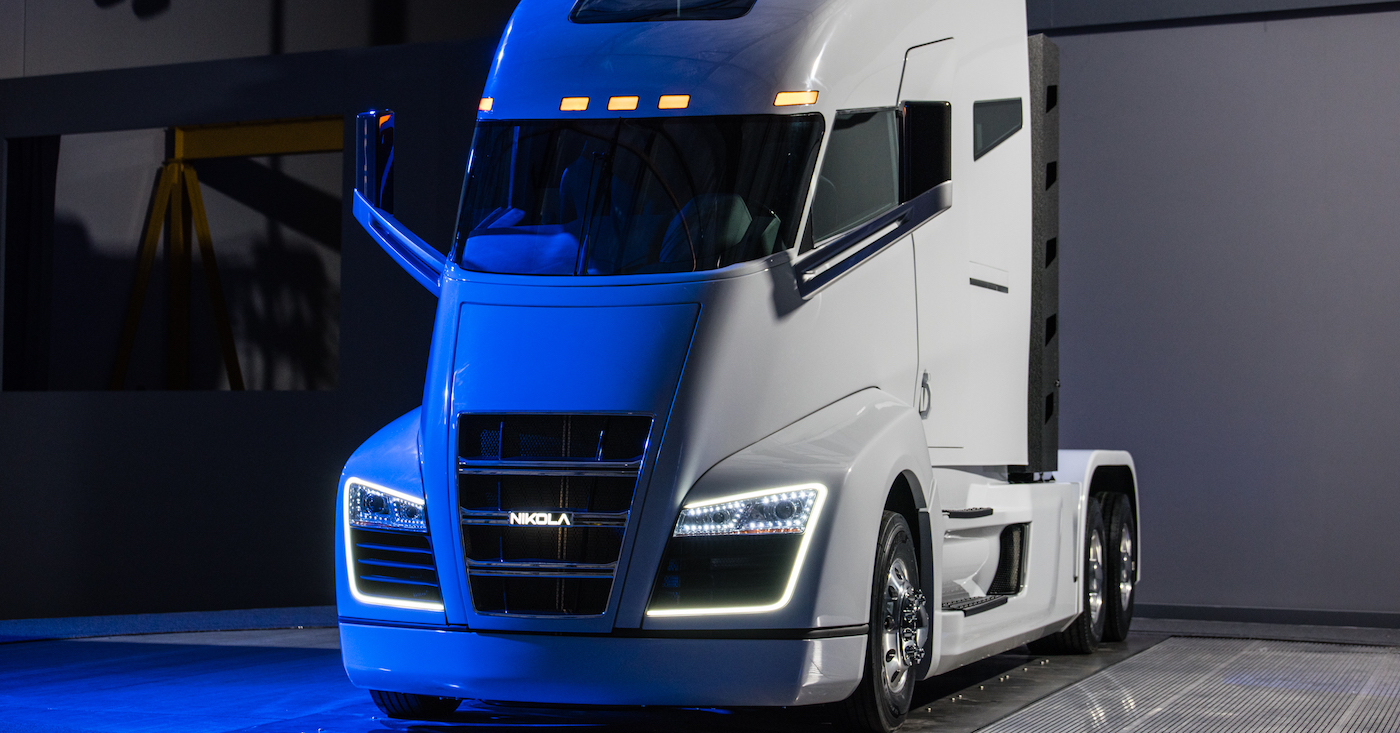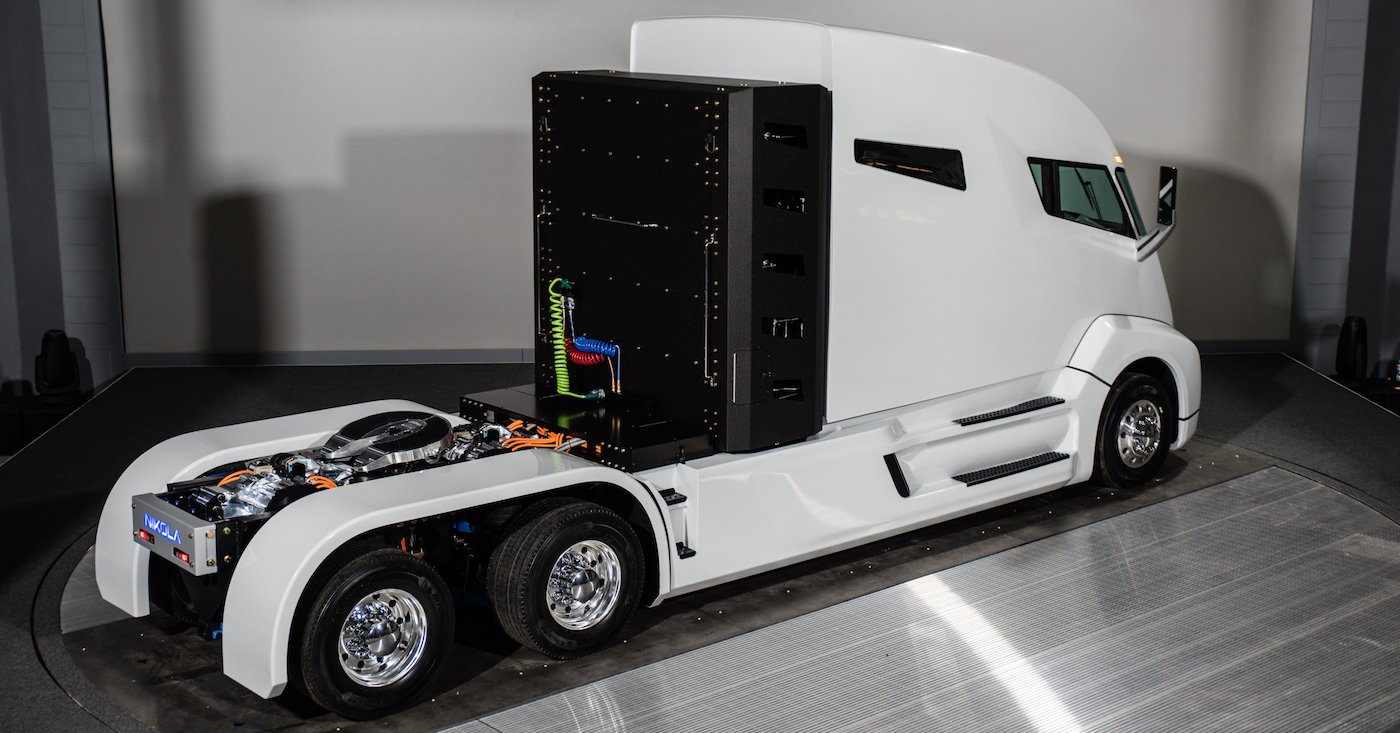News
Nikola Motor unveils 1,000 HP hydrogen-electric truck with 1,200 mi. range

Nikola Motor Company unveiled its zero emissions Class 8 truck at company headquarters this week. Dubbed the Nikola One, the once all-electric prototype now hydrogen powered, boasts an incredible 1,200 miles of range and will be stiff competition for Tesla’s planned entry into the long haul trucking segment with its all-electric Tesla Semi.
Nikola One is sleek and futuristic. Because it has no diesel engine, the cab can be pushed forward as far as possible to give the driver a panoramic view of the road ahead. Individual electric motors for each of its six wheels provides an incredible 1,000 horsepower and 2,000 lb-ft of torque. Both numbers are considerably higher than for a typical tractor.
Power comes from a 320 kWh battery developed by the company. “Our battery engineers have made major advances in storage and cooling,” said Nikola founder and CEO Trevor Milton. “We believe our lithium battery packs are more energy dense and weigh less than any available vehicle production pack per kWh.”
The company had previously designed Nikola One as an electric truck that would have a range extender via a turbine powered by natural gas. But at the reveal, the company announced the turbine has been replaced by a hydrogen fuel cell that will keep the battery charged and provide a range between 800 to 1,200 miles.
The prototype on display this week is technological marvel. An array of sensors and cameras permit the driver to have a full 360º view around the entire rig at all times, eliminating blind spots all together. Inside the cab there is room for a one or two full size beds, a refrigerator/freezer, a 40″ curved 4K TV with Apple TV, as well as Wi-Fi and 4G LTE connectivity. Comfort and convenience for the driver will be unparalleled.
The company says it is evaluating a number of locations for its factory. “Nikola will build a world-class advanced manufacturing facility which will create thousands of new jobs,” says Trevor Milton. He claims the factory will be able to build 50,000 trucks a year by 2020.
So far, one might be forgiven for thinking the Nikola One is mostly vaporware except for one thing. The company has struck a deal with Ryder Systems, which has agreed to be Nikola’s exclusive nationwide distribution and maintenance provider. Ryder has a network of over 800 service locations in North America today.
“We are extremely excited to finally show off the Nikola One to the public for the first time,” said Milton. “There are many out there that wondered if we would deliver, but today we proudly show off the most advanced semi-truck ever built. We couldn’t be more thrilled to have one of the best brands in America, Ryder, as our trusted partner providing nationwide sales, service and warranty for Nikola Motor Company.”
The financial plan for the company calls for leasing the trucks for 72 months at rates of between $5,000 and $7,000 a month. The lease fee will cover all scheduled maintenance at a Ryder facility and the cost of hydrogen fuel. Talking a page from the Tesla playbook, Nikola is accepting reservations for its battery/fuel cell Class 8 truck. It says it has received billions of dollars worth of deposits which cost $1,500 and are fully refundable.
Meanwhile, Elon Musk has let it be known that he also has his eye on the heavy truck market. We can be sure his vision for a Tesla Semi won’t involve any onboard fossil fueled range extender engines or what he dismissively calls “fool cells.”
The Coast of Hydrogen
Nikola says it intends to develop a network of 350 hydrogen fueling stations across North America for its trucks, beginning in 2018. It would be similar to the Supercharger network Tesla has been building to support long distance travel for its fleet of electric cars. But here’s the rub.
Hydrogen refueling stations cost $2 million or more to construct. It is estimated that a typical Tesla Supercharger location costs about one tenth as much to build. Exactly who will be paying for the hydrogen refueling system is unclear. And there are other issues with using hydrogen. Yes, the waste products of a fuel cell are water vapor and heat. But getting the hydrogen requires tremendous amounts of energy.
In the US, most hydrogen is derived from natural gas. Take the process back a step or two and that natural gas is often the result of fracking, a process that at the very least is controversial and at worst results in heavy pollution of the land and groundwater in the vicinity. Whether the Nikola One can accurately be called “zero emissions” is a matter for debate.

News
Tesla FSD fleet is nearing 7 billion total miles, including 2.5 billion city miles
As can be seen on Tesla’s official FSD webpage, vehicles equipped with the system have now navigated over 6.99 billion miles.

Tesla’s Full Self-Driving (Supervised) fleet is closing in on almost 7 billion total miles driven, as per data posted by the company on its official FSD webpage.
These figures hint at the massive scale of data fueling Tesla’s rapid FSD improvements, which have been quite notable as of late.
FSD mileage milestones
As can be seen on Tesla’s official FSD webpage, vehicles equipped with the system have now navigated over 6.99 billion miles. Tesla owner and avid FSD tester Whole Mars Catalog also shared a screenshot indicating that from the nearly 7 billion miles traveled by the FSD fleet, more than 2.5 billion miles were driven inside cities.
City miles are particularly valuable for complex urban scenarios like unprotected turns, pedestrian interactions, and traffic lights. This is also the difference-maker for FSD, as only complex solutions, such as Waymo’s self-driving taxis, operate similarly on inner-city streets. And even then, incidents such as the San Francisco blackouts have proven challenging for sensor-rich vehicles like Waymos.
Tesla’s data edge
Tesla has a number of advantages in the autonomous vehicle sector, one of which is the size of its fleet and the number of vehicles training FSD on real-world roads. Tesla’s nearly 7 billion FSD miles then allow the company to roll out updates that make its vehicles behave like they are being driven by experienced drivers, even if they are operating on their own.
So notable are Tesla’s improvements to FSD that NVIDIA Director of Robotics Jim Fan, after experiencing FSD v14, noted that the system is the first AI that passes what he described as a “Physical Turing Test.”
“Despite knowing exactly how robot learning works, I still find it magical watching the steering wheel turn by itself. First it feels surreal, next it becomes routine. Then, like the smartphone, taking it away actively hurts. This is how humanity gets rewired and glued to god-like technologies,” Fan wrote in a post on X.
News
Tesla starts showing how FSD will change lives in Europe
Local officials tested the system on narrow country roads and were impressed by FSD’s smooth, human-like driving, with some calling the service a game-changer for everyday life in areas that are far from urban centers.

Tesla has launched Europe’s first public shuttle service using Full Self-Driving (Supervised) in the rural Eifelkreis Bitburg-Prüm region of Germany, demonstrating how the technology can restore independence and mobility for people who struggle with limited transport options.
Local officials tested the system on narrow country roads and were impressed by FSD’s smooth, human-like driving, with some calling the service a game-changer for everyday life in areas that are far from urban centers.
Officials see real impact on rural residents
Arzfeld Mayor Johannes Kuhl and District Administrator Andreas Kruppert personally tested the Tesla shuttle service. This allowed them to see just how well FSD navigated winding lanes and rural roads confidently. Kruppert said, “Autonomous driving sounds like science fiction to many, but we simply see here that it works totally well in rural regions too.” Kuhl, for his part, also noted that FSD “feels like a very experienced driver.”
The pilot complements the area’s “Citizen Bus” program, which provides on-demand rides for elderly residents who can no longer drive themselves. Tesla Europe shared a video of a demonstration of the service, highlighting how FSD gives people their freedom back, even in places where public transport is not as prevalent.
What the Ministry for Economic Affairs and Transport says
Rhineland-Palatinate’s Minister Daniela Schmitt supported the project, praising the collaboration that made this “first of its kind in Europe” possible. As per the ministry, the rural rollout for the service shows FSD’s potential beyond major cities, and it delivers tangible benefits like grocery runs, doctor visits, and social connections for isolated residents.
“Reliable and flexible mobility is especially vital in rural areas. With the launch of a shuttle service using self-driving vehicles (FSD supervised) by Tesla in the Eifelkreis Bitburg-Prüm, an innovative pilot project is now getting underway that complements local community bus services. It is the first project of its kind in Europe.
“The result is a real gain for rural mobility: greater accessibility, more flexibility and tangible benefits for everyday life. A strong signal for innovation, cooperation and future-oriented mobility beyond urban centers,” the ministry wrote in a LinkedIn post.
News
Tesla China quietly posts Robotaxi-related job listing
Tesla China is currently seeking a Low Voltage Electrical Engineer to work on circuit board design for the company’s autonomous vehicles.

Tesla has posted a new job listing in Shanghai explicitly tied to its Robotaxi program, fueling speculation that the company is preparing to launch its dedicated autonomous ride-hailing service in China.
As noted in the listing, Tesla China is currently seeking a Low Voltage Electrical Engineer to work on circuit board design for the company’s autonomous vehicles.
Robotaxi-specific role
The listing, which was shared on social media platform X by industry watcher @tslaming, suggested that Tesla China is looking to fill the role urgently. The job listing itself specifically mentions that the person hired for the role will be working on the Low Voltage Hardware team, which would design the circuit boards that would serve as the nervous system of the Robotaxi.
Key tasks for the role, as indicated in the job listing, include collaboration with PCB layout, firmware, mechanical, program management, and validation teams, among other responsibilities. The role is based in Shanghai.
China Robotaxi launch
China represents a massive potential market for robotaxis, with its dense urban centers and supportive policies in select cities. Tesla has limited permission to roll out FSD in the country, though despite this, its vehicles have been hailed as among the best in the market when it comes to autonomous features. So far, at least, it appears that China supports Tesla’s FSD and Robotaxi rollout.
This was hinted at in November, when Tesla brought the Cybercab to the 8th China International Import Expo (CIIE) in Shanghai, marking the first time that the autonomous two-seater was brought to the Asia-Pacific region. The vehicle, despite not having a release date in China, received a significant amount of interest among the event’s attendees.










